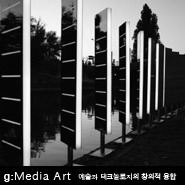이벤트
g: Media Art
예술과 테크놀로지의 창의적 융합 Lab[au]
브뤼셀을 무대로 활동하는 예술가 그룹 LAb[au]를 만난다. 테크놀로지를 창의적으로, 그리고 의미 있게 쓰는 것에 관심을 두고 있는 이들은, 테크놀로지라는 매개를 통해 동시대성을 반영한 예술 세계를 끊임없이 탐구해나가고 있다.
에디터. 유인경,
자료협조. ㈜카텔 크리에이티브(크리에이터 프로젝트)
www.thecreatorsproject.com/ko-kr
www.facebook.com/thecreatorsproject
@creators_sk

binary waves
cybernetic urban installation
Saint Denis, Paris _gare RER D, France / 2008
In the context of Biennale Art Grandeur Nature 2008
photos by LAb[au]
한국 독자들을 위해 소개를 부탁한다
LAb[au]는 건축과 도시성을 연구하는 실험실이다. LAb[au]는 1997년 첫 발을 내디딘 이후 지금까지 벨기에 브뤼셀에 위치한 스튜디오를 기반으로 활동하고 있다. 우리 스튜디오의 이름 LAb[au]는 음운적 의미와 문자적 의미가 결합되어 만들어졌다. 프랑스어 ‘labo(실험실)’에 독일어 ‘bau(건축, 조직)’가 결합된 것이다. 실험실이란 우리가 지향하는 실험적, 이론적 방법론을 의미하며 건축은 우리가 연구하는 대상을 지칭한다. 또한 이 이름에는 우리가 예술적 접근법과 이해를 형성하는데 주요한 역할을 한 1920년대의 바우하우스(Bauhaus) 운동에 대한 지향 역시 포함되어 있다. 바우하우스는 산업혁명의 영향을 예술의 형태와 방법론을 빌어 실험하는 움직임이었다. 오늘날 우리가 연구하는 영향은 산업혁명 뒤에 이어진 정보 혁명이다. 이러한 지향을 바탕으로 우리는 건축과 빛, 그리고 동역학(kinetics)을 결합한 설치 미술과 조소, 미술품들을 만들어내고 있다. LAb[au]의 프로젝트들은 서로 다른 규칙에 기반한 프로세스와 시스템을 다룬다. 설정된 규칙들은 작품의 콘텐츠와 메시지를 정의하는 주요한 예술적 활동으로 변화한다. 이것이 시스템으로써의 예술, 즉 시스템 예술(system art)이다.
Please introduce yourselves for our Korean readers.
LAb[au], laboratory for architecture and urbanism, is a studio based in Brussels, Belgium, which has been founded in 1997. The studio name - LAb[au] - merges a phonetic and a written meaning; that of the French pronunciation ‘labo’ and that of the German word ‘bau’. This refers to its experimental and theoretical approach - the one of a lab - and the one of construction – bau - of projects. Further, our name inhabits a reference to the 1920’s Bauhaus movement which plays an important role in our own artistic approach and understanding. The Bauhaus stands for a place examining the influence of the industrial revolution in the forms, methods and content of art. We nowadays face similar questions according to an information revolution. With this preoccupation in mind, we realize our installations, sculptures and artworks are all located in the crossing between architecture, light and kinetics. The projects of LAb[au] deal with processes and systems based on different rules. The setting of these rules becomes the major artistic act that defines the content and message of the artwork. It’s the conception of art as a system; it’s systems art.
새로운 의미 창출을 위해 테크놀로지를 창조적으로 사용하고자 노력하고 있는 것으로 알고 있다. LAb[au]의 근간을 이루는 철학에 관해 보다 자세히 설명해줄 수 있는가
LAb[au]의 멤버 세 명은 건축학적 배경을 가지고 있다. 우리는 우리의 예술적 아이디어를 작품으로 구현한다. 우리의 프로젝트는 강력한 건축적 사고를 담고 있다. 우리가 창조하는 모든 예술적 공간에는 우리가 공간을 바라보고 상상하는 방식이 반영된다. 우리는 이를 지각(perception)에서 인지(cognition)로의 이행 과정이라 설명한다. 이것이 우리 스튜디오가 다루는 중심적인 개념이다. 다시 말해, 테크놀로지적 관점에서 변화를 고민하고, 미적 결과물(예를 들면 ‘감각주의’와 같은)을 연출하는데 테크놀로지를 활용하는 것이다. 이러한 방식으로 우리는 매개체와 이것의 매개 변수, 코드, 지각 양식의 특수성을 다루며 그 특수성을 예술적 연구의 중심에 놓는 ‘구체 예술(art concrete)’ 운동과 유사한 방식으로, 다시 말해 예술을 미디어로서 접근한다.
이러한 우리 작업의 전반적인 자세와는 별개로, 우리의 접근법은 고도로 개념적이고 방법론적인 사고, 즉 앞에서 소개한 ‘시스템 예술’에 근거한다. 우리 프로젝트는 정교하게 구성된 프로세스 및 시스템 환경에 의해, 그리고 프로젝트의 최종 단계에 의해 특징지어진다. 그 결과 프로젝트의 초기 규칙(환경)은 예술적 탐구에서 주요한 역할을 하게 된다. 이리하여 우리의 프로젝트들은 생성, 반응, 대화 등의 시스템들과 그 근간에 자리 잡은 ‘규칙들’을 통해 이해될 수 있는 것이다.
우리의 프로젝트를 이해하는 또 다른 방법은 ‘콘셉트’를 읽는 것이다. ‘콘셉트’는 우리의 프로젝트에서 현재적으로 보여지는, 그리고 보다 개인적인 관심을 반영하는 아이디어이다. 예를 들어 <binary waves>와 같은 프로젝트는 주변 전자기장의 측정을 통해 작업이 이뤄졌다. 포착된 데이터는 설치물의 동작 양식뿐 아니라 조명에도 영향을 미친다. 이 방식을 통해 반응 시스템은 주변 활동을 반영하고 현대 도시 공간에 존재하는 보이지 않는 층을 시각화하게 된다. 도시의 흐름(FLUX)과 동적 조명(LUX) 장치 사이의 이러한 관계는 우리가 ‘fLUX’라 명명한 개념에 초한다. 중요한 점은 우리에게 있어 이 장치는 단순히 포착된 데이터를 시각화하는 역할이 아닌, 그 데이터를 통해 자신만의 동적 발광 공간을 축하는 역할을 한다는 점이다.
또한, 우리의 작업은 테크놀로지의 발달에 기반한 것이 아니다. 오히려 이와는 반대로 테크놀로지가 우리에게 현대의 ‘대상’들을 개념화할 해결책을 제시해준 것이다. 예를 들어, 형상 기억 물질은 사건과 형태 사이의 관계에 대한 우리의 생각을 바꿔 주었다. 형태 형성(morphogenesis)이나 디지털 제작(digital fabrication)이 그러했듯 말이다. 주된 문제는 이것이다. 우리는 어떻게 이 테크놀로지들에, 그리고 이들이 제공하는 가능성에 보다 깊은 의미를 새겨넣을 수 있을까?
We understand that you wish to use technology creatively in rder to make new meanings. Can you explain the philosophy behind Ab[au]?
The architectural background of the three members of LAb[au] is present in our artistic work. Our projects relay a strong architectural thinking. We qualify this relation as: from sense (perception) to sense (cognition). This notion is a central topic in the studio’s discourse; mostly when looking from a technological perspective considering the changes, technologies operate on questions of representation as on aesthetic issues such as ‘the sensual’. In this manner we approach art as a media comparable to the ’art concrete’ movement, which deals with the specificities of a medium, its parameters, codes, perception modalities and places them right into the centre of the artistic investigation. Besides this general positioning of our work, our approach is grounded on a highly conceptual and methodological thinking, which can best be described as systems art. Our projects are characterised by the setting of processes and systems in the elaboration, realisation and in its final state of a project; consequently their inherent rules - the setting - become an important part of our artistic quest. Our projects thus can be understood by the systems such as generative, reactive, interactive … and its ‘rules’ they are based upon.
Another reading of our projects is the one of ‘concepts’. The ‘concepts’ are ideas which appear currently in our projects and they reflect a more personal interest. For example, a project like ‘binary waves’ is based on the measurement of the electromagnetic fields of its surroundings. The captured data drives the kinetic behaviour of the installation as much as it influences its illumination. In this manner, the reactive system mirrors the activity of its surroundings and reveals an existing invisible layer of our contemporary urban space. This relation between urban flows (FLUX) and a kinetic light (LUX) installation is based upon on a concept which we call ‘fLUX’. For us it is important to mention that the installation is not a visualisation of the captured data, but uses this data like matter to construct its own kinetic-luminous space.
Our work is not grounded in the development of technology, but in contrary shows that technology allows us to conceptualise these ‘subjects’ today. For example, smart materials transform our understanding of the relationship between matter and form just as algorithmic morphogenesis and digital fabrication does. The main question here is: how we can give these technologies and the possibilities they offer a deeper meaning?

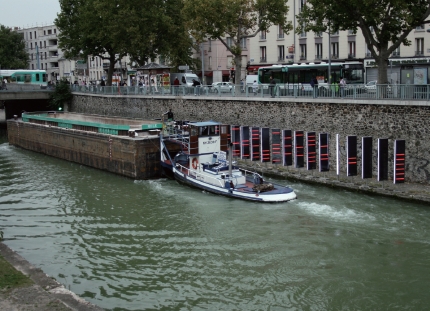
binary waves
cybernetic urban installation
Saint Denis, Paris _gare RER D, France / 2008
In the context of Biennale Art Grandeur Nature 2008
photos by LAb[au]
영감은 어디에서 얻나
주로 크게 두 곳에서 영감을 얻는다. 하나 우리 작업의 방법론 자체이고 다른 하나는 20세기 아방가르드(avantgarde) 관련 자료이다. 우리의 방법론은 시스템과 콘셉트, 대상이라는 세 개의 주요한 개념적 축으로 정의될 수 있다. 이들은 우리가 아이디어를 조직하는 기준을 형성할 뿐 아니라 우리에게 새로운 프로젝트를 생각해내도록 하는 역할을 하기도 한다. fLUX의 개념에 기초해 색을 사용하는 반응 프로젝트는 어떤 게 있을까?’ 이런 고민에서부터 새로운 프로젝트의 틀이 형성되는 것이다.
다음으로 제기되는 의문은 ‘서로 다른 기준 요소들을 어떤 방식으로 구성할 것인가?’라는 것이다. 이를 위한 첫 번째 단계는 프로젝트의 콘셉트와 구현 방식, 그리고 실제적 상태 안에서의 테크놀로지의 역할을 분석하는 것이다. 이러한 분석은 시스템적 측면에서 우리의 프로젝트를 평가하는 단계로 이어진다. 결과적으로 디지털이나 복수/혼합 미디어, 테크놀로지 등에 관하여 생각하지 않게 되는 것이다. 대신 우리는 프로세스와 시스템에 관하여 생각한다. 이는 우리가 테크놀로지가 아닌 프로젝트에 관한 개념적 해석을 진행할 수 있도록 해준다. 실용적인 관점에서 우리는 개발과 실현 과정 모두를 자체적으로 처리한다. 이를 통해 테크놀로지를 보다 잘 이해할 수 있기 때문이다. 핵심은 테크놀로지 그 자체가 아니다. 우리가 진정으로 원하는 것은 테크놀로지를 보다 창조적인 방식으로 관리하는 것이다. 예를 들어 fLUX의 개념은 혼잡이라는 문제에 관한 우리의 건축적, 도시적 해답에서 출발했다. 도시는 언제나 흐름이라는 관념과 밀접한 연관을 지니며 생성되고 발전해왔다. 물과 같은 자연의 흐름뿐 아니라 경제나 문화, 혹은 인프라스트럭처 등 우리가 살아가는 환경의 모든 곳에는 ‘흐름’이 존재하지 않는가? 이러한 흐름은 현대로 들어서며 정보/커뮤니케이션이라는 형태로 우리의 도시를 변화시키고 있다. 기차와 자동차가 중세의 도시 구조를 바꿔놓았듯 말이다. 흐름과 도시라는 개념은 <binary waves> 프로젝트의 원천이 되었고 나아가 fLUX의 콘셉트로까지 이어졌다. 이는 우리가 지속적으로 작업을 진행중인 10개의 대주제 중 하나이다.
Where do you find your inspiration?
There are two major sources of inspiration: the first one derives directly from our work methodology and the other is our reading of the 20’s century avantgarde. Our methodology is defined by the crossing of three major conceptual axes: by systems, by concepts and by subjects. They not only form a grid which structures our ideas, but also allow us to conceive new projects. For example, what would be a reactive project which is based on the concept of fLUX and uses color? Voila. A frame of a new project is set.
Now the question is: how do we constitute the different elements of the grid? The first step was to analyze the role of technology in the conception, production and actual state of the project. This analysisresulted in our evaluation of our projects by systems, consequently we don’t think in terms of digital, multi or mixed media/technology; we think in terms of processes and systems. This allows us to conceptualize rather the project than the technology. From a practical point of view, we develop and realize everything in-house, since we want to better understand technology not because it’s technology - but because we want to master it in a creative and controlled manner. For example the concept of fLUX is the result of our architectural and urban projects dealing with questions of congestion. Cities always have been built in close relation with the notion of flows, whether it is natural flows of water, economic, cultural or infrastructural ones, they all shape our living environment. Nowadays information and communication flows transform our cities in the same way that trains and cars transformed the mediaeval city maze. This general reflection about flows and the city motivated the project ‘binary waves’ and led to the concept fLUX, which now is one of our 10 concepts we recurrently are working on.
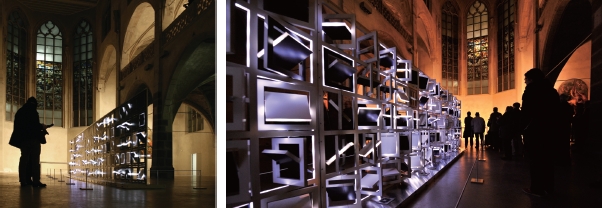
framework 5x5X5
kinetic light installation, Kunst-Station Sankt-Peter, Koln, Germany / 2010
Exhibition: m0t1f
photos by Stephan Bredgen
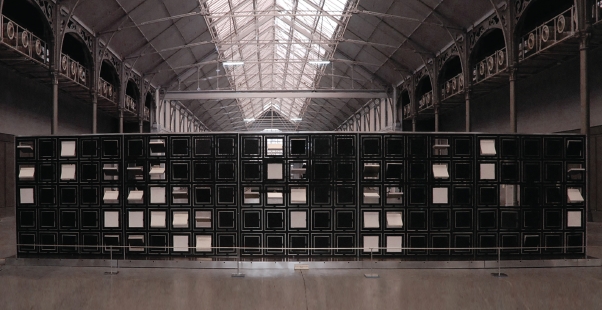
framework 5x5X5
kinetic light installation, centquatre, Paris France / 2010
In the context of Nemo festival
photo by LAb[au]
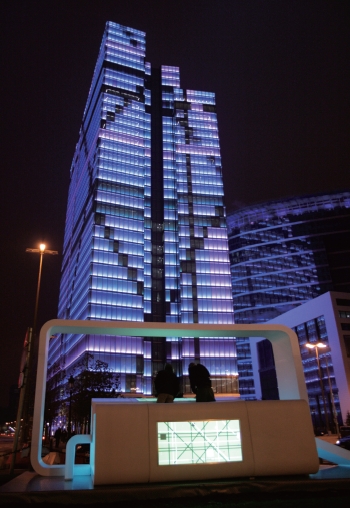
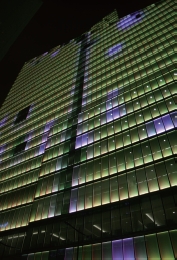
Touch
Interactive urban installation
Illumination project for the Inauguration of Dexia-Tower,
Place Rogier Brussels, Belgium / 2007
photos by LAb[au]
* 기사의 전문은 <지콜론> 8월호에서 확인하실 수 있습니다.
review
게시물이 없습니다
Q & A
게시물이 없습니다
shipping, exchange, return guide
고객님께서 주문하신 상품은 입금 확인후 배송해 드립니다. 다만, 상품종류에 따라서 상품의 배송이 다소 지연될 수 있습니다.
교환 및 반품이 가능한 경우
- 상품을 공급 받으신 날로부터 7일이내
단, 포장을 개봉하였거나 포장이 훼손되어 상품가치가 상실된 경우에는 교환/반품이 불가능합니다.
- 공급받으신 상품 및 용역의 내용이 표시.광고 내용과
다르거나 다르게 이행된 경우에는 공급받은 날로부터 3월이내, 그사실을 알게 된 날로부터 30일이내
교환 및 반품이 불가능한 경우
- 고객님의 책임 있는 사유로 상품등이 멸실 또는 훼손된 경우.
단, 상품의 내용을 확인하기 위하여 포장 등을 훼손한 경우는 제외
- 포장을 개봉하였거나 포장이 훼손되어 상품가치가 상실된 경우
- 고객님의 사용 또는 일부 소비에 의하여 상품의 가치가 현저히 감소한 경우
- 시간의 경과에 의하여 재판매가 곤란할 정도로 상품등의 가치가 현저히 감소한 경우
- 복제가 가능한 상품등의 포장을 훼손한 경우
(자세한 내용은 고객만족센터 1:1 E-MAIL상담을 이용해 주시기 바랍니다.)
※ 고객님의 마음이 바뀌어 교환, 반품을 하실 경우 상품반송 비용은 고객님께서 부담하셔야 합니다.

